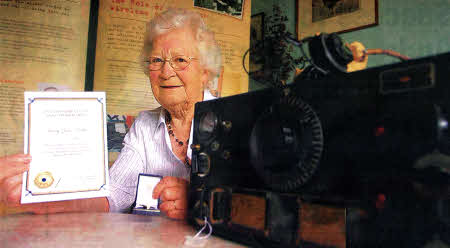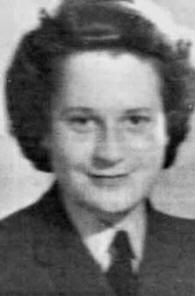Mary reveals her secret war time role
by JULIE ANN SPENCE

Mary Davis, who served in the RAF during the war as a code cracker. US2810-101A0
A HILLSBOROUGH woman who was part of the team which intercepted German radio messages during the Second World War has spoken for the first time about the incredible life and secrecy of a job people didn't even know existed.
Mary Davis's work was so secret that it was 40 years before the role played by those intercepting and breaking the German codes could be revealed.
Now, after Mary and others involved in the work received recognition from Prime Minister David Cameron, the Hillsborough lady has spoken to the Star and revealed details of her role.
 Mary, who is originally from Belfast, worked at a 'Y Station' in England,
intercepting German messages which were then passed on to the code breakers
at Bletchley Park. It is now acknowledged the work of Mary and others like
her helped to shorten the war by some two years.
Mary, who is originally from Belfast, worked at a 'Y Station' in England,
intercepting German messages which were then passed on to the code breakers
at Bletchley Park. It is now acknowledged the work of Mary and others like
her helped to shorten the war by some two years.
Sworn to secrecy for years, Mary has only just started to reveal details of her work at the listening station and has spoken publicly for the first time about the part she played.
Her story came to light when George Bushby, a volunteer at the Somme Heritage Centre near Bangor, was given her name by one of her good friends, Rosemary Dalzell. George, who gives regular talks to groups, had been researching the history and purpose of two World War Two 'Y Stations' in Northern Ireland. Through one of his talks Rosemary passed Mary's name to George, knowing that she had been connected to the work of the codebreakers at Bletchley Park.
Mary left her Belfast home at the age of 17 and a half and travelled to England where she was trained to be a wireless operator. "My parents went berserk when I joined'' explained Mary. "My father, with his experience of life at the Battle of the Somme, tried to persuade me to stay at home.
My mother was demented at losing her only daughter, but I stood firm.
"I set off for my interview, which was conducted by a very friendly, mature English officer who persuaded me away from my very keen ambition to be an MT driver. She explained that wireless operators were very badly needed and on reflection that may well have been the early beginnings of Enigma."
Mary set off in her Sunday best and travelled to Gloucester for initial training and then to Morecombe before being sent to the London Radio College where she spent eight hours a day learning Morse code. She was also sent on a six week course to Compton Bassett to learn how to dismantle and reassemble wireless sets.
"Coming from reasonably sheltered homes we suddenly became numbers'" she continued. "I was 2097978 Aircraft Woman and was paid the princely sum of 11 shillingser week - about 55p. We were issued with uniforms and the most dreadful underwear - old fashioned knickers in RAF blue for summer and woolen navy blue for winter, henceforth known as 'twilights' and 'blackouts'. We were also given our knife, fork and spoon, known as 'irons' and a huge mug.
"From Gloucester we were posted to Morecombe to learn 'square bashing' or drill to the uninitiat- ed, around the streets of the town.
"Then we were all split up according to the trades we were to train in. I had to report to the London Radio College in Chiswick. I had never been out of Ireland before and London at first scared me half to death though I did grow to love it."
After training Mary spent the rest of the war stationed at Chicksands Priory, spending hours on end listening painstakingly to German messages, which were being relayed via Morse code. Mary and the other listeners wrote down the code received, which was passed to the code breakers at Bletchley Park where the encryption was cracked by the now famous Enigma machine.
It was only when the secrets of Bletchley Park began to be unearthed in the 1970s that Mary realised the importance of her work which, she admits, at times could be tedious.
"We had to be so focussed, you went into a trance," explained Mary. "It was never a clear signal. There would be music or something in the background and you would have to press the earphones to your head to try to hear the signal.
"There were 22 girls in our Hut'" she continued. They called us the Hags of 125 because that was our hut number. We had an iron bed, the mattress was in three parts called 'biscuits', a wooden bomb box to keep under the bed and four large hooks on the wall to hang our clothing and our kit bags. I still have mine with my number painted on it.
"We worked three watches - 8am - 4pm, 4pmmidnight and midnight -8am. In the early weeks we worked solidly with no breaks, not even for a cup of tea. Later flasks of hot tea and biscuits were allowed in and we had a 15 minute break in each watch. We could not leave our sets without a relief. We called out 'relief'' continued writing to the left side of our pads and slid off our seats while our relief slid onto the right of the seat and carried on - not a second was wasted."
Even Mary and the other women who worked In the Y Station didn't understand the importance of their work.
"The site was top secret and I understand it still is," she said. "It was to be forty years before the details of our work were released. We wireless operators at Chicksands and other stations intercepted all German messages being transmitted in Morse code. These were then rushed by dispatch rider to Bletchley where the famous machines and those brainy operators decoded them. I have read many times that Churchill read many messages before Hitler. We were told that we had our own title. We were to be known as the 'Y Service' and must never breathe a word to anyone about what we did."
One day Mary and the other ladies at Chicksands found out just how seriously the vow of silence had to be taken. "One of our girls who came from a small village told her mother more than she should about our work," Mary explained. "A new girl was posted in and visited her new in-laws in the same village and realised what had happened and reported it. The MPs came to our hut and arrested Jenny, who was put into close confinement. We were not allowed too speak to her. She slept alone in a hut and was marched back and forward to the cook house. It was a big warning to all of us."
It wasn't all work for Mary. whose nickname at the time was Murphy, because she had asked for more potatoes one day.
Our camp was ten miles from Bedford and most of us had our bikes shipped to the camp. We cycled ten miles into the town, danced all evening and cycled ten miles back.
"It seems amazing that such a disparate group of girls should blend in so well. At the age of 17 I was the baby of the hut. I left one mother at home and acquired 21 more! They were terrific girls and looked after me until I grew up."
At the end of the war Mary celebrated along with her friends before signing up to begin yet another chapter in her life.
"VE Day arrived and everyone went wild. We cycled to Bedford and joined in parties everywhere. Our legs ached from dancing on the grass. We paused at the side of the road to listen to a nightingale singing its heart out as if it understood what was happening. It is the one and only time I have ever heard one sing.
"Shortly after I applied for and got a posting to the Middle East. It was a sad time when we had to leave because we had been together for so long."
It was during her time in Cairo that Mary met her husband George, who was returning to England from his posting as a fighter pilot in the Far East. The couple eventually returned first to London and then to Northern Ireland, where they settled finally in Hillsborough and raised their family. Over sixty years after she began her service at the Y Station Mary, along with anyone connected to the work of Bletchley Park, was recently recognised for her part in the war effort.
She received a gold plated badge and a certificate, signed by Prime Minister David Cameron. "I was shocked to receive it," said Mary, who has always been modest about her vital work.
If you know of anyone who had connections with the Y Service during World War Two, the researchers at the Somme Heritage Centre would like to hear from you. They can be contacted at the Centre on 9182 3202.
julieann.spence@ulsterstar.co.uk
Ulster Star
23/07/2010

